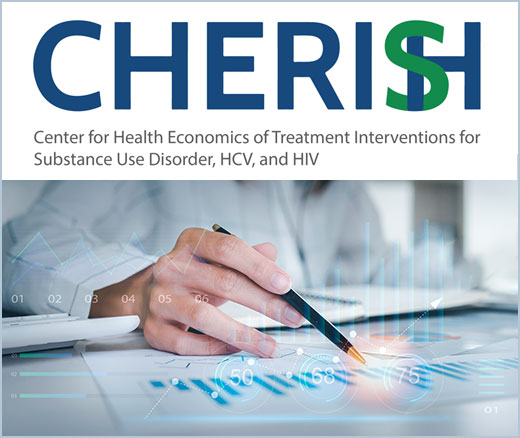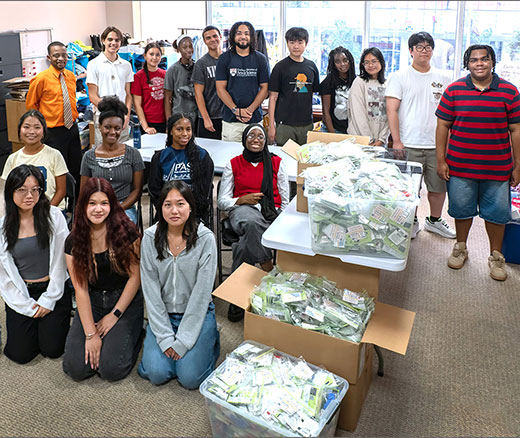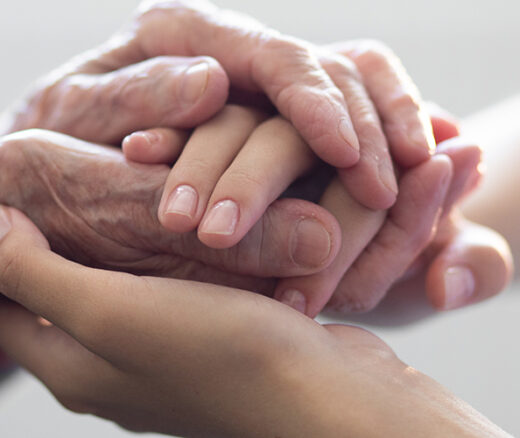
New Model Predicts Stimulant Overdose Risk Among Medicaid Patients
LDI Fellows Used Medicaid Data to Identify Individuals at Highest Risk for Cocaine- and Methamphetamine-Related Overdoses, Paving the Way for Targeted Prevention
Substance Use Disorder
Blog Post

Christopher Allen was ready for a fresh start. On an unseasonably warm afternoon in March, Allen, in his early 30s, walked to the 6800 block of Woodland Avenue in Southwest Philadelphia, where a Mobile Overdose Surge Response Bus from Prevention Point Philadelphia, a nonprofit public health agency, was parked. In an almost street-fair-like atmosphere, snacks, packages of the opioid overdose reversal drug Narcan, and drug test strips were offered on fold-up tables. Reverend MacIvan Rogers of the nearby St. James Church of Kingsessing, a strong supporter of the Prevention Point bus, stopped by to chat. Three physicians from the University of Pennsylvania’s Perelman School of Medicine evaluated eight clients, while case managers from Prevention Point helped them find jobs and housing. And staffers from the city’s Department of Behavioral Health and Intellectual disAbility Services told passersby about their mental health services.
The professionals here “are all really good at making people feel comfortable,” said Judy Chertok, Director of Addiction Medicine in the department of Family Medicine and Community Health at the University of Pennsylvania.

After a 45-minute visit, Allen had renewed a prescription for Suboxone, a drug that cuts opioid cravings and dramatically reduces the risk of overdosing, and he joined a counseling program. He felt that stopping by a van for medications for opioid use disorder (MOUD) was preferable to visiting a clinic or doctor’s office, places that in the past had made him feel unwelcome. “People got edgy in there,” he recalled.
Others share Allen’s discomfort. “There is some evidence that many people won’t go to traditional medical settings to seek health care,” said LDI Senior Fellow Shoshana Aronowitz, Assistant Professor in the Department of Family and Community Health at Penn Nursing. “The point of street medicine is to meet people where they are and provide care if they don’t want to or can’t go into a clinic.”
Street medicine, practiced out of a van or literally on the streets, just got a boost. In October, the federal government announced that it would allow providers to bill for services delivered in a “non-permanent location on the street or found environment.” States such as Pennsylvania, California, and Hawaii had already made this move to increase access to care for people at risk, especially the unhoused and those with substance use disorders.
The main beneficiaries are practices that seek out people living in hard-to-reach places like encampments. But the shift is important, even for operations like Kensington-based Prevention Point and Northeast Philadelphia’s Courage Medicine, brick-and-mortar clinics that already receive Medicaid reimbursement for services performed from their vans.
“The point-of-service billing change is a step in the right direction. It legitimizes street medicine in a way that hasn’t happened before. But there are a lot of things that need to also happen to actually increase the availability of mobile medicine,” said Catherine Abrams, Program Coordinator for Substance Use Response Guidance and Education (SURGE), a training arm of the nonprofit Health Federation of Philadelphia.

Drug-related deaths have been increasing throughout the city for decades. In 2022, the last year for which figures are available, fatal drug overdoses in Philadelphia hit a peak of 1,413, with people of color hit hardest. Over 80% of the overdose fatalities in 2022 involved opioids—almost always fentanyl. When the city’s fatality figures were released last October, then-Mayor Jim Kenney said, “It is no longer accurate to call this an opioid epidemic; it is an overdose epidemic driven by an increasingly contaminated drug supply.”
One newer drug is xylazine, a non-opioid animal tranquilizer that can be added to fentanyl or heroin. Also known as “tranq,” xylazine was reported in 34% of overdose deaths. Even when not fatal, the drug can cause serious wounds in many users—not just at injection sites but all over the body.
“Many of our patients who use xylazine experience necrotizing wounds that kill tissues,” said LDI Associate Fellow Eleanor Turi, a Postdoctoral Fellow at the Perelman School of Medicine’s Center for Mental Health and a wound-care nurse with Courage Medicine. Amputations may follow.
Philadelphia offers a large range of treatment options for drug users, but a recent report funded by the Pew Charitable Foundation noted significant barriers. Waits to be seen—up to 18 hours—pose serious problems for people with jobs and childcare, and those who might go into withdrawal. Transportation to the centers is also difficult. Many clinics also require intensive counseling, which has not been shown to improve outcomes.

Methadone distribution, in particular, is highly regulated by the federal government and requirements for treatment—such as daily check-ins—are so stringent that the opioid agonist has been dubbed “liquid handcuffs.”
In a 2023 paper by Aronowitz, LDI Senior Fellow Margaret Lowenstein, Chertok, and other Prevention Point professionals, one of the group’s clients said, “It’s like getting up every morning and trying to get a bag of dope, because I had to get up every morning and go get the methadone.”
Street medicine units offer a different, low-threshold approach that has been shown to greatly increase access to medication in Chicago, Seattle, San Francisco, and New Jersey. In this model, the treatment team comes to clients, either where they’re living or parked close by.
Mobile units offer same-day MOUD prescriptions, don’t require counseling sessions, and, unlike many traditional programs, will continue treatment even if individuals are not completely abstinent from drugs. “For other illnesses, such as diabetes, we routinely tolerate imperfect adherence to medication or behavior changes. So why should we withhold evidence-based, highly-effective treatment from people with substance use disorders?” said Lowenstein, an Assistant Professor of Medicine at Perelman and practicing addiction medicine physician who formerly provided mobile treatment with Prevention Point.
With the group’s mobile van, patients are mainly stabilized with Suboxone, a medication that combines buprenorphine, a synthetic opioid, with naloxone, an opioid antagonist. The once-a-week bus remains in a neighborhood for three to six months. Patients are eased into more permanent care, such as compatible primary care practices. “Sometimes that works, sometimes it doesn’t. I think in some cases people like the mobile situation so much that they don’t want to go somewhere else,” said Aronowitz.
Philadelphia has at least 11 street medicine practices (both the van and feet-on-the-ground type) with two more on the way, according to SURGE’s Abrams. “That may seem like a lot, but the teams are not seeing many people a day. The problem is that they are under-resourced,” she said.
What would more money buy? “Ideally, programs would offer a diverse range of services with an interdisciplinary team that provides mental health care, peer counseling, wound care provided by a nurse, sexually transmitted disease testing and treatment, snacks, and sandwiches. A lot of these programs want to do all these things and what’s stopping them is that they don’t always have the funding,” said Aronowitz.

Most mobile and street units need monies from grants and donations to supplement payments received from Medicaid and other insurers. Places like Prevention Point and Courage Medicine won’t turn away people who lack insurance. “The bigger issue is that we can’t get reimbursed at the full cost of the care. The payers are reimbursing at 50% of the claim, and that’s really what makes it difficult to pay for medical care,” said Silvana Mazzella, Interim Lead Executive Officer of Prevention Point.
In addition, some crucial services are not billable to Medicaid. For instance, Prevention Point gives checks to people to buy state ID cards, which are necessary to fill MOUD prescriptions at some pharmacies.
Getting grant money year after year can be “a scramble,” according to Kevin Moore, Executive Director of Courage Medicine.
“But for street medicine to succeed, you have to make funding sustainable,” SURGE’s Abrams said.
One attempt to improve financial support is the DIRECT Care for the Homeless Act of 2023, a congressional bill that would create a four-year pilot program to increase street medicine operations. But it is stalled in a House committee. In the meantime, help couldn’t come any sooner. “The opioid crisis is an all-hands-on-deck situation,” said Abrams.
The homeless crisis and the drug overdose epidemic are intertwined in America. Depending on the neighborhood, about 25% to 75% of the clients using Prevention Point Philadelphia’s Mobile Overdose Surge Response Bus are unhoused.
Substance use is common among people experiencing homelessness, and overdose is one of their leading causes of death, said LDI’s Lowenstein. “People experiencing homelessness also have a harder time accessing substance use treatment—and health care in general—and face more complications from their substance use,” she said. That’s why many local experts put more affordable housing in Philadelphia at the top of the list for strategies to combat the overdose epidemic.
A recent change in Medicaid billing that encourages street medicine—care delivered at non-permanent locations—came about as part of the Biden administration’s plan to significantly reduce the unhoused population by 2025.
Here are some strategies proposed by experts to increase the effectiveness and availability of street and mobile medicine for people with substance use disorders and other issues.
1. Reimburse registered nurses (RNs) for treating wounds
Wounds are one of the most serious side effects of xylazine, the tranquilizer drug that has become ubiquitous in the Philadelphia area. “We cannot bill Medicaid for the wound care provided by our RNs because, per state regulations, there must be a physician or advanced practice care provider on our street medicine team, which is not the case. Medicaid support of these services would increase by 1,000% our ability to treat more people (and in some cases save more lives) of the ‘street homeless’ of Bucks County,” said Julie Dees, CEO of the Family Service Association of Bucks County.
2. Speed up Medicaid payments
About 98% of adults on Medicaid in Pennsylvania belong to Medicaid Managed Care groups, which influences how quickly providers are paid. “The difference between straight Medicaid and Medicaid Managed Care is that when you send a bill to straight Medicaid, they just pay you,” said Kevin Moore, Executive Director of Courage Medicine, which focuses on treatment for opioids and sexually transmitted diseases. “And when you send it to Medicaid Managed Care, they review it and then they wait maybe 60 to 90 days, and then they reject it, or they partially reject it, then you send it back in and so on. If the Pennsylvania Insurance Commissioner and the Pennsylvania Medicaid Program were much harder on the Medicaid Managed Care organizations, we could use those dollars more effectively.”
3. Increase mail service
About 90% of people using Prevention Point’s mobile van are signed up for Medicaid. One reason that’s possible is that the Kensington-based center operates a mail station for clients. “We have a form letter that says they’re using our mailing address, and then we use that to help them apply for benefits,” said Silvana Mazzella, Interim Lead Executive Officer of Prevention Point.
Downtown, over 5,000 people use Broad Street Ministry’s mail address as their own. But the city needs many more stations for unhoused people.
4. Encourage staff recruitment and retention with loan forgiveness
Staff retention is difficult at many community-based organizations dealing with opioid use. “It’s not just that you have to deal with a lesser salary, it’s also that you’re on the front lines and the working conditions are rough. We had a patient die today,” said Moore. A bipartisan congressional bill co-sponsored by U.S. Rep. Summer Lee, D-Pittsburgh, proposed that medical and other personnel of street medicine clinics be eligible for student loan forgiveness or pauses. “This incentivizes providers to work in street medicine,” said Tori DeLeonardo, Legislative Assistant to Lee.


LDI Fellows Used Medicaid Data to Identify Individuals at Highest Risk for Cocaine- and Methamphetamine-Related Overdoses, Paving the Way for Targeted Prevention

Penn and Four Other Partners Focus on the Health Economics of Substance Use Disorder

Penn Medicine’s New Summer Intern Program Immersed Teens in Street Outreach Techniques

LDI Experts Offer 10 Solutions to Get More Help to Seniors With Addiction

More Flexible Methadone Take-Home Policy Improved Patient Autonomy
Research Brief: LDI Fellow Recommends Ways to Increase Availability